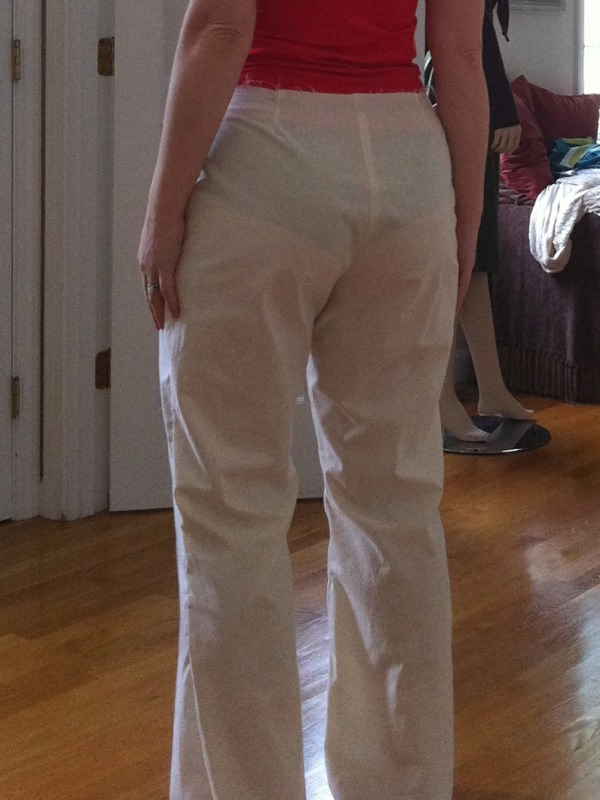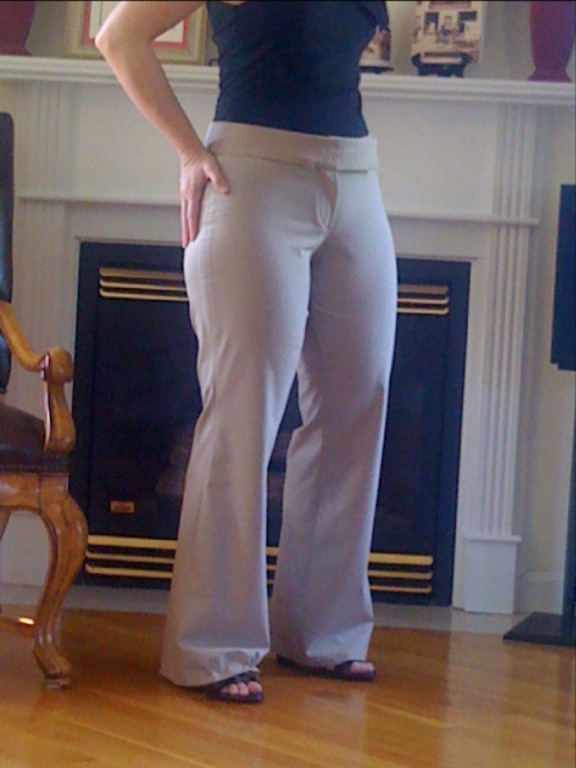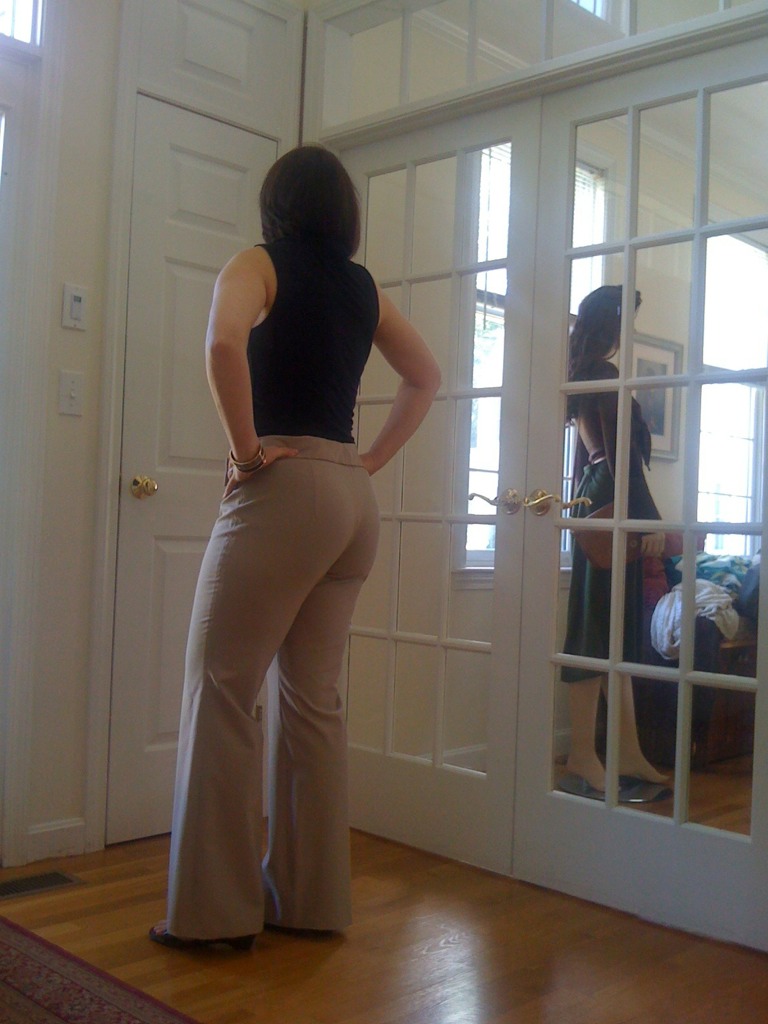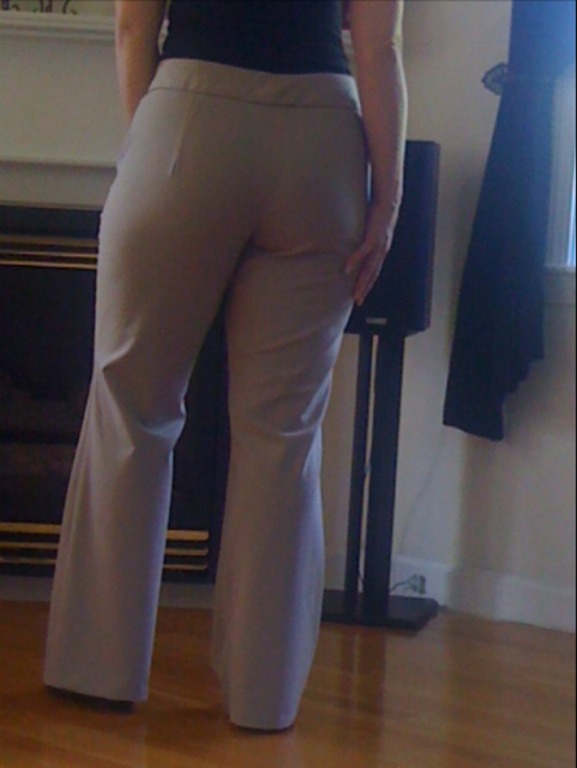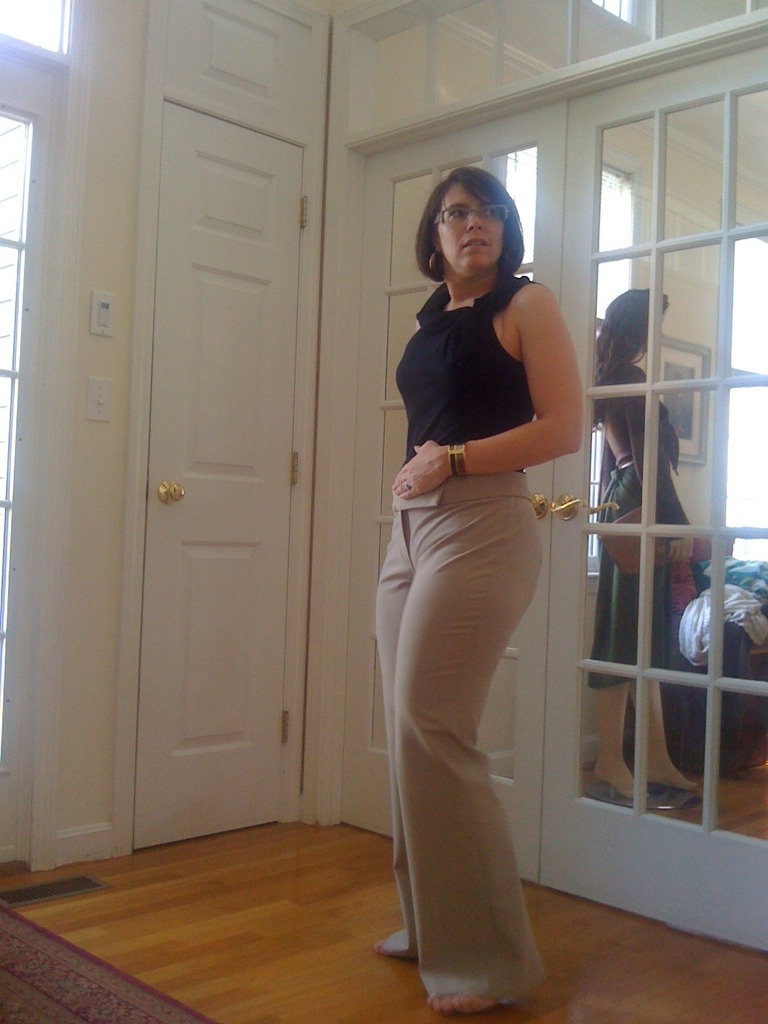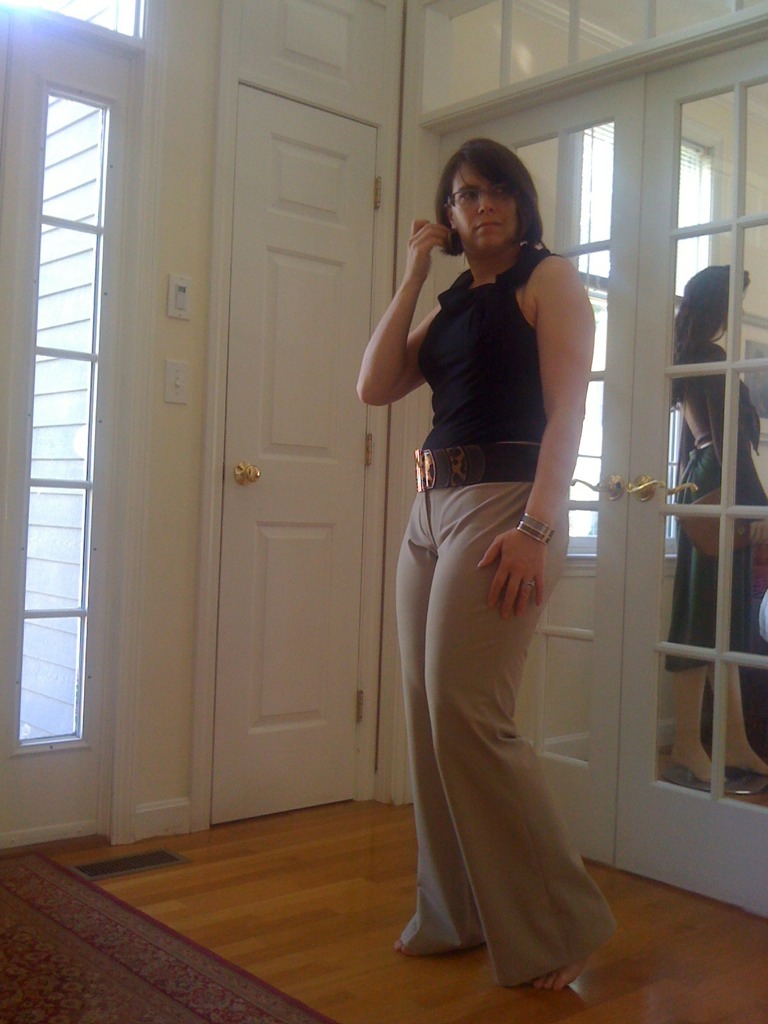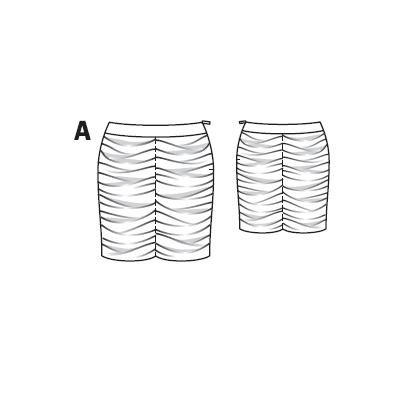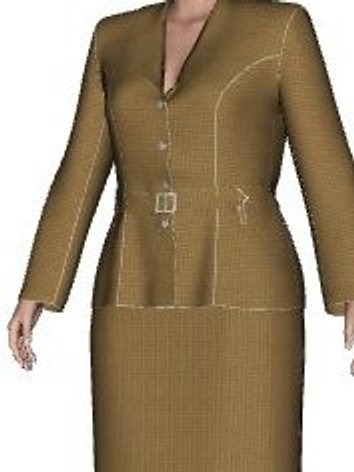
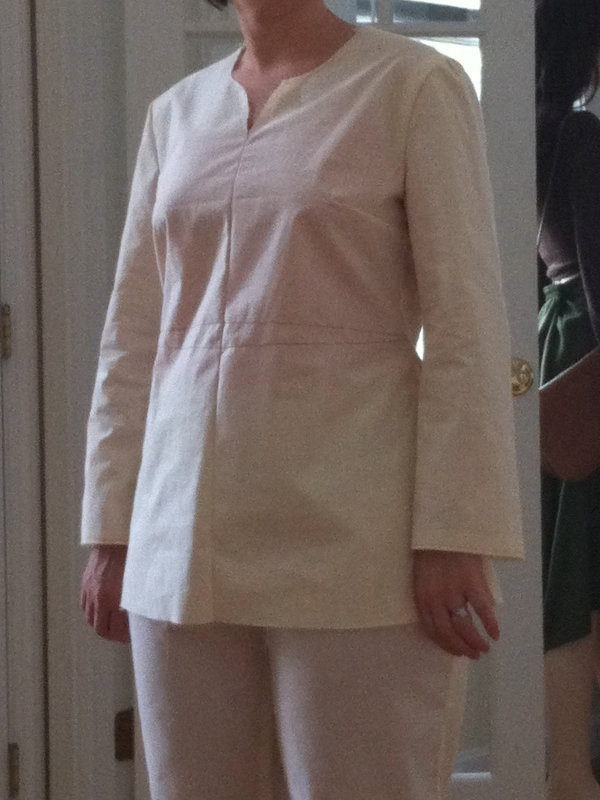 Can I just gush for a few minutes about Bernina My Label? I LOVE this software! The model looks so much like me, I am embarrassed to post a picture of her without clothes on.
Can I just gush for a few minutes about Bernina My Label? I LOVE this software! The model looks so much like me, I am embarrassed to post a picture of her without clothes on.Although the model on the left is wearing a different style than the muslin I am wearing in the photo on the right, you can see that the figures have the same posture and all the curves are in the right places and have the same proportions. The model is wearing shoulder pads and a bra. I am wearing just a cotton/Lycra camisole under the tunic, which accounts for the slight difference - if you even noticed it!
I looked at this program and downloaded the demo a while ago, but I decided I didn't need it at the time. Then I read about Robin's success with it here and I started to think I would really like having a virtual model to help me decide what to sew. I still wasn't ready to go ahead and buy the program, though, because I have two other pattern drafting programs which I never use. Also the program only has 20 different styles, so my assumption was that I would still be using commercial patterns and doing edits anyway. As much as I wanted to play with the model and try different styles on, I felt it was not a practical purchase.
Instead, I had my body scanned at Unique Boutique and I intended to purchase custom patterns from a retailer who would draft them according to my scanned measurements. When I got my measurements and my point cloud image, I was shocked to learn that my body is very asymmetrical. At the time, I was just beginning to suffer from frozen shoulder. I quickly lost most of the range of motion in my left shoulder and arm. I couldn't use a hair dryer, or dress myself for a while. My head is not centered and I have one shoulder that is higher and has a shorter seam length. The condition pulls at my neck causing it to be off axis. I also have a protuding scapula on the frozen side. In light of all this, I decided to focus on fitting pants until my frozen shoulder goes away. In the last several months, I have recovered much of my range of motion and I feel normal again, but I still have a slightly asymmetrical figure. During the process of trying to fit pants, I made several unsuccessful attempts and finally in a moment of desparation, I dashed out to buy the software.
There are not too many mathematical or geometrical things which challenge me the way making pants does. In fact, I can think of no greater challenge I have had with anything topological. I was convinced I could do this myself and it became a matter of pride not to buy the program even though in my heart of hearts, I lusted after it.
Once I knew I wanted it, I still needed a reason to swallow my pride and pony up the cash. I think it was my frustration with being so close and every time I thought I was fixing something, my pants got worse. Buying the software was my way of looking the answer up in the back of the book - so to speak. I wanted to get a good draft and reverse engineer it to see what I was doing wrong. I bought it impulsively and I am glad I got it. I think of it as I think of all the books I read about sewing. It is a source of inspiration and information, and I think it will accelerate me to where I want to be with my sewing - making clothes I can actually wear.
The program works really well. Yes, I have two other pattern drafting programs but this one is different. It lets me try things on my body. Some styles won't look right on my body or fit me well even if they are custom designed for me by the program. This is because the number of measurements used to make a custom draft are too few to cover every single figure variation known to mankind. Some people are just going to have to make manual alterations. Because of this, Bernina has given users fantastic support though forums, webinars, and documentation as well as personal email. This support has made the BIGGEST difference for me. I feel as though Bernina cares about each and every one of us home sewing enthusiasts and they have decided to teach us everything we may possibly need to know in order to be successful. They use pictures - lots and lots of pictures - to illustrate every detail of instruction. I have had more than one Ah-HAH moment reading through the PDF documents they post on line at the yahoo user group.
The actual pattern drafts are spot on. Seams which are sewn together are equal. The curves do not have jaggy-looking points along them. There are match points and circles 3/8" from dart points (called drill holes) which allow me to place tailors tacks right where I need them - or clips and tiny holes if I feel very confident. The ability to see the custom pattern stitched up on my body before I cut into fabric is a real time saver. I can tell if I am going to need to tweak a pattern before I even attempt it.
Some things the software does not do which would be useful for me are:
- Allow asymmetrical model measurements - right now, you have to save a right and a left model and tape the different pattern pieces together down the middle. This is great, but I cannot simulate any garment on an asymmetrical model, so I cannot see if I will need to go through the trouble of using a separate left and right side. Some styles are more forgiving than others and may not need left and right sides. I would like to be able to tell before I sew.
- There is no way to export the pattern pieces so I can edit them in a drafting program.
- When using a plotter with roll fed paper, I still need to specify the exact length of paper I will need, because the program generates match marks at the four corners of whatever sized paper I tell it I am using. If I tell it I have a twelve foot roll of 36" paper, it will print one page - 12 feet x 36 inches. There goes my whole roll of paper! If I could eliminate the match points for printouts which only require one sheet, my ploter would print only what I need and I wouln't have to monkey around with the page size for each printout.
- The program will simulate some Bernina embroidery designs and print marks on the pattern to help you place the stichout exactly where you want it. This is fantastic! I can tell if the design needs to be a little to the left, or a smidge higher, etc... I would like to be able to import my own embroidery designs. The instructions say to choose a similar design and use that to approximate. I could do that, but then the coolness of knowing exactly where the design will stitch out is lost.
All in all, I think this program and I are going to have a long and fruitful relationship. I cannot wait to sew my Fall 2010 wardrobe. I will be able to wear pants! You have no idea what this means to a girl who is always cold. Sure, I love my dresses and tights, but now I will have another option. I do not have to put up with pants whose waist gapes away from my body in the back, or pants with big wrinkles pointing to the crotch, or pant legs that are way too tight in the thighs and huge everywhere else. I don't have to wear ultra low rise pants which reveal my underwear in the back when I sit down. I won't have to wear long, untucked shirts and blouses which end at the mid thigh level - the place where I want to focus the LEAST amount of attention. And hey, that belted jacket on the model doesn't look half bad. I make whip myself up one of those as well. Now, all I need is more TIME to play with my new toy!


